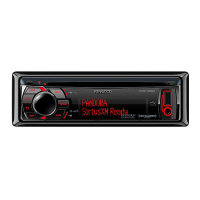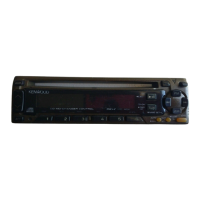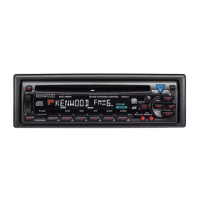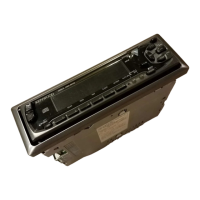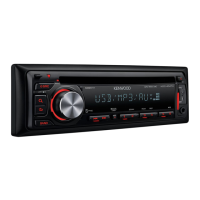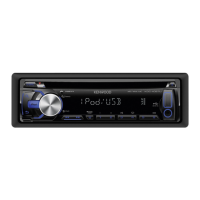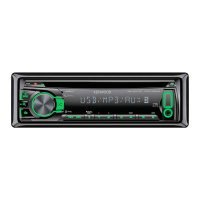Do you have a question about the Kenwood KDC-4022 and is the answer not in the manual?
Important safety warnings regarding injury, fire, and hazardous radiation exposure.
Information on FCC compliance, RF energy generation, and potential interference.
Precautions against electrical shorts, sharp edges, and improper handling of the unit.
Guidelines to prevent damage from heat, dust, moisture, and physical shock.
Information on compatible CD players/changers and unsupported connections.
Warning against inserting 3-inch CDs with adapters due to potential damage.
Tips for installation issues, reset button usage, and LCD readability in cold temperatures.
Instructions for cleaning the unit, faceplate terminals, and CD slot, plus lens fogging advice.
Reference to the Sirius tuner manual for operation when connected.
Details on compatible media types, ISO 9660 formats, and file naming restrictions for MP3s.
Explains ID3 tag display and requirements for file/folder names for MP3 playback.
Guidelines for setting bit rate, sampling frequency, and writing MP3 files to media.
How files and folders are accessed and how to potentially control playback order.
An illustration showing folder and file structure for MP3 playback.
Instructions for handling, cleaning, and storing CDs to prevent damage.
Information on CDs that cannot be used, including roundness, dirt, coloring, and unfinalized discs.
How to turn the unit ON and OFF using the SRC button.
How to select different audio sources like Tuner, CD, or Auxiliary input.
Instructions for increasing and decreasing the volume using the VOL knob.
How to select and adjust preset sound settings for different music types.
Detailed controls for bass, treble, balance, fader, and other audio parameters.
Setting the speaker type to optimize System Q performance.
How to turn the non-fading output feature ON or OFF.
How to cycle through different information displays using the DISP button.
Procedure for attaching custom titles to stations or CDs.
How to select the display label for the Auxiliary input source.
Step-by-step guide on how to detach the front faceplate for security.
Instructions for properly reattaching the removable faceplate to the unit.
How to choose between Auto seek, Preset station seek, and Manual tuning modes.
Steps for selecting FM/AM bands and tuning to stations using seek or preset buttons.
Using the remote to directly enter a frequency for tuning.
How to store and recall favorite radio stations using preset buttons.
Automatically storing the strongest stations in the memory.
How to call up stations stored in the preset memory.
Illustration and labels of the main control buttons on the unit.
Steps for inserting and playing CDs and MP3 discs.
How to play discs from an optional accessory disc player.
Controls for fast forwarding and reversing tracks on a disc.
Searching for specific tracks or files on a disc or MP3.
Selecting a disc from a changer or a folder on an MP3 disc.
Entering a track or file number to access it directly.
Entering a disc number to access it directly from a changer.
Repeating a track, disc, or folder during playback.
Playing tracks or folders in a random order.
Playing all discs in a changer in random order.
Playing the beginning of each track to find desired music.
Quickly selecting a specific folder on an MP3 disc.
Scrolling displayed text like CD Text, MP3 info, or MD title.
Selecting a CD from the changer that has a preset name.
Basic steps for entering and navigating the menu system for settings.
Setting or entering a security code to prevent theft.
Enabling or disabling the beep sound for button operations.
Setting the internal clock for time display.
Setting the red LED indicator to blink when the faceplate is removed.
Choosing the button illumination color between red and green.
Selecting different display modes like Demonstration or Normal.
Setting the main display color to a desired hue.
Adjusting the contrast level of the unit's display.
Enabling automatic display dimming with the vehicle's light switch.
Displaying or hiding System Q factor details in Audio Control.
Selecting between rear preout and non-fading preout.
Toggling the mute control on the built-in amplifier for preout quality.
Making front and rear channels play different sources simultaneously.
Adjusting bass boost levels for external amplifiers.
Setting the central frequency for bass boost.
Switching FM reception between stereo and mono to reduce noise.
Setting how text information scrolls on the display.
Enabling or disabling the built-in auxiliary input function.
Forcing playback of CDs with special formats or MP3s.
Illustration of the remote control and its buttons.
How to load and replace batteries in the remote control.
Explanation of Volume, Source, and Attenuate buttons.
Using remote buttons for tuner functions like band selection and presets.
Using remote buttons for disc playback, search, and naming.
List of accessories provided with the unit for installation.
Step-by-step guide for installing the unit in a vehicle.
Labels and descriptions for each wire in the wiring harness.
Diagram showing how to connect power, speakers, and control wires.
Specific instructions for installing the unit in Japanese-made cars.
Important cautions regarding screw usage and installation force.
Steps for fastening the faceplate to the main unit to prevent it from falling off.
Guide on how to remove the protective rubber frame.
Instructions for safely detaching the main unit from the car dashboard.
Solutions for power issues, source switching, memory erasure, and loudness.
Troubleshooting no sound, low volume, poor quality, and non-fading output problems.
Diagnosing issues with touch sensor tone, dimming, and high-pass filters.
Addressing display color changes and poor radio reception.
Resolving problems with disc insertion, playback, skipping, and MP3 display.
Explanations for error codes like Eject, No Disc, TOC Error, E-05, E-77, Mecha Error.
Meanings of messages like Hold Error, No Name, Load, Reading, No Access, and IN (Blink).
Technical specifications for the FM tuner including frequency range and sensitivity.
Technical specifications for the AM tuner including frequency range and sensitivity.
Technical specifications for the CD player, including laser, filter, and speed.
Technical specifications for the audio output, including power and tone controls.
General specifications like operating voltage, current consumption, and weight.
Explains the importance of the card for replacing a stolen or damaged front panel.
Details to fill out on the equipment pass for important documentation.
Information about the Kenwood stereo's compatibility with Sirius satellite radio.
Benefits of Sirius's digital sound quality and S>PLEX technology.
How Sirius enhances the radio experience with artist and song information.
Encourages users to try Sirius online and visit a dealer for system completion.
Lists Sirius music channels including Pop, Dance, Rock, Latin, and Country.
Details Sirius channels for Jazz, Standards, Swing, and Broadway music.
Lists Sirius channels for Latin music and various Country music categories.
Covers Sirius channels for R&B, Soul, Classical music, and Voices.
Lists Sirius channels for Blues, Reggae, Gospel, World Music, and Kids.
Lists Sirius channels for news from various providers like CNN, NPR, and Bloomberg.
Lists Sirius channels dedicated to sports coverage from ESPN and others.
Lists Sirius channels for entertainment, comedy, arts, and talk shows.
Describes the Sirius tuner as the nerve center for satellite signal processing.
Details the specially designed antenna for capturing satellite signals.
Encourages users to subscribe to Sirius and locate a retailer.
Fields for identifying the product type, model, and serial number.
Space for dealer stamp, signature, and contact information.
Fields to record the date of purchase for warranty purposes.
Fields for the customer's name, address, and contact details.
Specifies the one-year warranty duration from the original purchase date.
Details what defects are covered and excluded by the warranty.
Explains who is protected by the warranty and what Kenwood pays for.
Steps to follow for getting warranty service, including shipping and proof of purchase.
Information on implied warranties, liability limits, and damages.
Important safety warnings regarding injury, fire, and hazardous radiation exposure.
Information on FCC compliance, RF energy generation, and potential interference.
Precautions against electrical shorts, sharp edges, and improper handling of the unit.
Guidelines to prevent damage from heat, dust, moisture, and physical shock.
Information on compatible CD players/changers and unsupported connections.
Warning against inserting 3-inch CDs with adapters due to potential damage.
Tips for installation issues, reset button usage, and LCD readability in cold temperatures.
Instructions for cleaning the unit, faceplate terminals, and CD slot, plus lens fogging advice.
Reference to the Sirius tuner manual for operation when connected.
Details on compatible media types, ISO 9660 formats, and file naming restrictions for MP3s.
Explains ID3 tag display and requirements for file/folder names for MP3 playback.
Guidelines for setting bit rate, sampling frequency, and writing MP3 files to media.
How files and folders are accessed and how to potentially control playback order.
An illustration showing folder and file structure for MP3 playback.
Instructions for handling, cleaning, and storing CDs to prevent damage.
Information on CDs that cannot be used, including roundness, dirt, coloring, and unfinalized discs.
How to turn the unit ON and OFF using the SRC button.
How to select different audio sources like Tuner, CD, or Auxiliary input.
Instructions for increasing and decreasing the volume using the VOL knob.
How to select and adjust preset sound settings for different music types.
Detailed controls for bass, treble, balance, fader, and other audio parameters.
Setting the speaker type to optimize System Q performance.
How to turn the non-fading output feature ON or OFF.
How to cycle through different information displays using the DISP button.
Procedure for attaching custom titles to stations or CDs.
How to select the display label for the Auxiliary input source.
Step-by-step guide on how to detach the front faceplate for security.
Instructions for properly reattaching the removable faceplate to the unit.
How to choose between Auto seek, Preset station seek, and Manual tuning modes.
Steps for selecting FM/AM bands and tuning to stations using seek or preset buttons.
Using the remote to directly enter a frequency for tuning.
How to store and recall favorite radio stations using preset buttons.
Automatically storing the strongest stations in the memory.
How to call up stations stored in the preset memory.
Illustration and labels of the main control buttons on the unit.
Steps for inserting and playing CDs and MP3 discs.
How to play discs from an optional accessory disc player.
Controls for fast forwarding and reversing tracks on a disc.
Searching for specific tracks or files on a disc or MP3.
Selecting a disc from a changer or a folder on an MP3 disc.
Entering a track or file number to access it directly.
Entering a disc number to access it directly from a changer.
Repeating a track, disc, or folder during playback.
Playing tracks or folders in a random order.
Playing all discs in a changer in random order.
Playing the beginning of each track to find desired music.
Quickly selecting a specific folder on an MP3 disc.
Scrolling displayed text like CD Text, MP3 info, or MD title.
Selecting a CD from the changer that has a preset name.
Basic steps for entering and navigating the menu system for settings.
Setting or entering a security code to prevent theft.
Enabling or disabling the beep sound for button operations.
Setting the internal clock for time display.
Setting the red LED indicator to blink when the faceplate is removed.
Choosing the button illumination color between red and green.
Selecting different display modes like Demonstration or Normal.
Setting the main display color to a desired hue.
Adjusting the contrast level of the unit's display.
Enabling automatic display dimming with the vehicle's light switch.
Displaying or hiding System Q factor details in Audio Control.
Selecting between rear preout and non-fading preout.
Toggling the mute control on the built-in amplifier for preout quality.
Making front and rear channels play different sources simultaneously.
Adjusting bass boost levels for external amplifiers.
Setting the central frequency for bass boost.
Switching FM reception between stereo and mono to reduce noise.
Setting how text information scrolls on the display.
Enabling or disabling the built-in auxiliary input function.
Forcing playback of CDs with special formats or MP3s.
Illustration of the remote control and its buttons.
How to load and replace batteries in the remote control.
Explanation of Volume, Source, and Attenuate buttons.
Using remote buttons for tuner functions like band selection and presets.
Using remote buttons for disc playback, search, and naming.
List of accessories provided with the unit for installation.
Step-by-step guide for installing the unit in a vehicle.
Labels and descriptions for each wire in the wiring harness.
Diagram showing how to connect power, speakers, and control wires.
Specific instructions for installing the unit in Japanese-made cars.
Important cautions regarding screw usage and installation force.
Steps for fastening the faceplate to the main unit to prevent it from falling off.
Guide on how to remove the protective rubber frame.
Instructions for safely detaching the main unit from the car dashboard.
Solutions for power issues, source switching, memory erasure, and loudness.
Troubleshooting no sound, low volume, poor quality, and non-fading output problems.
Diagnosing issues with touch sensor tone, dimming, and high-pass filters.
Addressing display color changes and poor radio reception.
Resolving problems with disc insertion, playback, skipping, and MP3 display.
Explanations for error codes like Eject, No Disc, TOC Error, E-05, E-77, Mecha Error.
Meanings of messages like Hold Error, No Name, Load, Reading, No Access, and IN (Blink).
Technical specifications for the FM tuner including frequency range and sensitivity.
Technical specifications for the AM tuner including frequency range and sensitivity.
Technical specifications for the CD player, including laser, filter, and speed.
Technical specifications for the audio output, including power and tone controls.
General specifications like operating voltage, current consumption, and weight.
Explains the importance of the card for replacing a stolen or damaged front panel.
Details to fill out on the equipment pass for important documentation.
Information about the Kenwood stereo's compatibility with Sirius satellite radio.
Benefits of Sirius's digital sound quality and S>PLEX technology.
How Sirius enhances the radio experience with artist and song information.
Encourages users to try Sirius online and visit a dealer for system completion.
Lists Sirius music channels including Pop, Dance, Rock, Latin, and Country.
Details Sirius channels for Jazz, Standards, Swing, and Broadway music.
Lists Sirius channels for Latin music and various Country music categories.
Covers Sirius channels for R&B, Soul, Classical music, and Voices.
Lists Sirius channels for Blues, Reggae, Gospel, World Music, and Kids.
Lists Sirius channels for news from various providers like CNN, NPR, and Bloomberg.
Lists Sirius channels dedicated to sports coverage from ESPN and others.
Lists Sirius channels for entertainment, comedy, arts, and talk shows.
Describes the Sirius tuner as the nerve center for satellite signal processing.
Details the specially designed antenna for capturing satellite signals.
Encourages users to subscribe to Sirius and locate a retailer.
Fields for identifying the product type, model, and serial number.
Space for dealer stamp, signature, and contact information.
Fields to record the date of purchase for warranty purposes.
Fields for the customer's name, address, and contact details.
Specifies the one-year warranty duration from the original purchase date.
Details what defects are covered and excluded by the warranty.
Explains who is protected by the warranty and what Kenwood pays for.
Steps to follow for getting warranty service, including shipping and proof of purchase.
Information on implied warranties, liability limits, and damages.
| Brand | Kenwood |
|---|---|
| Model | KDC-4022 |
| Category | Car Receiver |
| Language | English |

